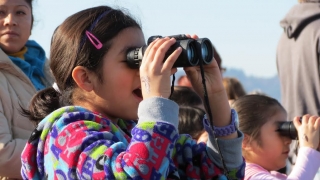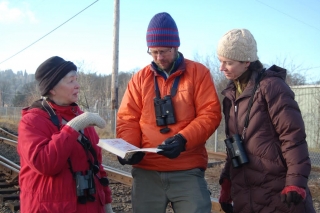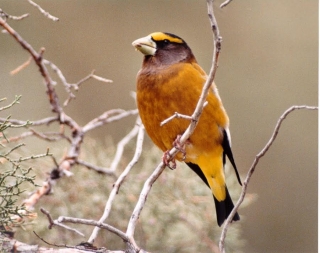This Valentine’s Day is for the birds
Joe Liebezeit, February 5 2014
 Do you like birds? (Sure you do!) Do you know how to count? (It’s ok if you need to use your fingers)
Do you like birds? (Sure you do!) Do you know how to count? (It’s ok if you need to use your fingers)
If your answer is “yes” on both fronts, here’s a global citizen science project you should know about – a way to put those counting skills to use to help research bird populations.
This Valentine’s Day kicks off the 17th annual Great Backyard Bird Count, a fun opportunity for folks of all ages to explore the wild birds that live just outside their doorstep, while contributing to a better understanding of our feathered friends. Your assistance helps conservationists determine which bird populations are in trouble and how best to protect them. This year, I plan to participate with my 4-year-old daughter, who already has fun identifying crows, robins and chickadees in our neighborhood.
 If you’re new to citizen science or birding, this is a great way to get your feet wet: You can spend as little as 15 minutes identifying and counting birds. And, it’s no problem if you are a beginning birder and don’t recognize all the birds you see. When you submit data to the Great Backyard Bird Count website, just say that you weren’t able to identify certain birds.
If you’re new to citizen science or birding, this is a great way to get your feet wet: You can spend as little as 15 minutes identifying and counting birds. And, it’s no problem if you are a beginning birder and don’t recognize all the birds you see. When you submit data to the Great Backyard Bird Count website, just say that you weren’t able to identify certain birds.
The count runs for four days, and during this period, you can conduct just one or multiple counts at practically any location – from your own backyard to a nearby natural area. You can even do the count from the comfort of your own living room, if you have a bird feeder that can be viewed from a window.
 The National Audubon Society and Cornell Lab of Ornithology combine the data from this count with information from other citizen science projects, including the Christmas Bird Count and Ebird, a real-time, online bird checklist program. The Christmas Bird Count, an annual effort similar to the Great Backyard Bird Count, was initiated more than 100 years ago by National Audubon, and Ebird is now one of the fastest growing biodiversity databases in existence. Millions of bird sightings are entered into Ebird on a monthly basis!
The National Audubon Society and Cornell Lab of Ornithology combine the data from this count with information from other citizen science projects, including the Christmas Bird Count and Ebird, a real-time, online bird checklist program. The Christmas Bird Count, an annual effort similar to the Great Backyard Bird Count, was initiated more than 100 years ago by National Audubon, and Ebird is now one of the fastest growing biodiversity databases in existence. Millions of bird sightings are entered into Ebird on a monthly basis!
This vast pool of data helps scientists understand big-picture trends in bird populations. To date, more than 200 studies have been published using citizen science information. These studies have helped us understand a lot about bird distribution and the ways birds’ ranges have changed over time, like how the European Starling has expanded its range in the Americas or how the Western Screech Owl has experienced range contractions. Some of studies document significant population declines, which help bolster arguments for listing imperiled species under the Endangered Species Act (a crucial step for protecting threatened birds).
Citizen science has helped us gained a better understanding of the impact of catastrophic weather events on bird populations. And, in one recent study, citizen science data was even used to document the impact of climate change on the timing of bird migration.
 Participation in the Great Backyard Bird Count has increased steadily in Portland over the last few years. Check out 2012, when a total of 230 checklists were submitted from Portland, tallying a total of 97 species and more than 26,000 individual birds. The most common species detected were Cackling Geese, but the counts also included some interesting rarities like the Gray Jay, Eurasian Wigeon, Mountain Chickadee, and Prairie Falcon.
Participation in the Great Backyard Bird Count has increased steadily in Portland over the last few years. Check out 2012, when a total of 230 checklists were submitted from Portland, tallying a total of 97 species and more than 26,000 individual birds. The most common species detected were Cackling Geese, but the counts also included some interesting rarities like the Gray Jay, Eurasian Wigeon, Mountain Chickadee, and Prairie Falcon.
If you want to take part in an effort to help save bird species and have fun while doing it, join this year’s Great Backyard Bird Count!
For more information and to register, visit the Great Backyard Bird Count website or contact me by email.

 Joe Liebezeit is the Avian Conservation Program Manager for the
Joe Liebezeit is the Avian Conservation Program Manager for the
Add new comment